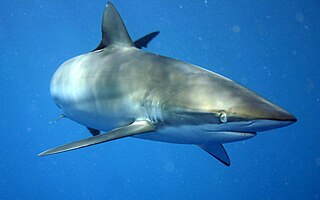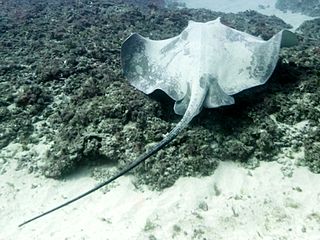
The hammerhead sharks are a group of sharks that form the family Sphyrnidae, named for the unusual and distinctive form of their heads, which are flattened and laterally extended into a cephalofoil. The shark's eyes are placed one on either end of this T-shaped structure, with their small mouths directly centered and underneath. Most hammerhead species are placed in the genus Sphyrna, while the winghead shark is placed in its own genus, Eusphyra. Many different— but not necessarily mutually exclusive—functions have been postulated for the cephalofoil, including sensory reception, manoeuvering, and prey manipulation. The cephalofoil gives the shark superior binocular vision and depth perception.

The silky shark, also known by numerous names such as blackspot shark, gray whaler shark, olive shark, ridgeback shark, sickle shark, sickle-shaped shark and sickle silk shark, is a species of requiem shark, in the family Carcharhinidae, named for the smooth texture of its skin. It is one of the most abundant sharks in the pelagic zone, and can be found around the world in tropical waters. Highly mobile and migratory, this shark is most often found over the edge of the continental shelf down to 50 m (164 ft). The silky shark has a slender, streamlined body and typically grows to a length of 2.5 m. It can be distinguished from other large requiem sharks by its relatively small first dorsal fin with a curving rear margin, its tiny second dorsal fin with a long free rear tip, and its long, sickle-shaped pectoral fins. It is a deep, metallic bronze-gray above and white below.

Sphyrna is a genus of hammerhead sharks with a cosmopolitan distribution in the world's oceans. Members of Sphyrna have a tendency to inhabit coastal waters along the intertidal zone rather than the open ocean, as their prey such as invertebrates, fish, rays, small crustaceans, and other benthic organisms hide in the sands and sediment along these zones. Members of Sphyrna are also known by synonyms such as Zygaena, Cestracion, and Sphyrichthys. The earliest species described of this genus was Sphyrna zygaena by Carl Linnaeus in 1758, while the latest described member, Sphyrna gilberti, was discovered and described in 2013.

The great hammerhead is the largest species of hammerhead shark, belonging to the family Sphyrnidae, attaining an average length of 4.6 m (15 ft) and reaching a maximum length of 6.2 m (20 ft). It is found in tropical and warm temperate waters worldwide, inhabiting coastal areas and the continental shelf. The great hammerhead can be distinguished from other hammerheads by the shape of its "hammer", which is wide with an almost straight front margin, and by its tall, sickle-shaped first dorsal fin. A solitary, strong-swimming apex predator, the great hammerhead feeds on a wide variety of prey ranging from crustaceans and cephalopods, to bony fish, to smaller sharks. Observations of this species in the wild suggest that the cephalofoil functions to immobilize stingrays, a favored prey. This species has a viviparous mode of reproduction, bearing litters of up to 50 pups every two years.

The winghead shark is a species of hammerhead shark, and part of the family Sphyrnidae. Reaching a length of 1.9 m (6.2 ft), this small brown to gray shark has a slender body with a tall, sickle-shaped first dorsal fin. Its name comes from its exceptionally large "hammer", or cephalofoil, which can be as wide as half of the shark's total length. The function of this structure is unclear, but may relate to the shark's senses. The wide spacing of its eyes grants superb binocular vision, while the extremely long nostrils on the leading margin of the cephalofoil may allow for better detection and tracking of odor trails in the water. The cephalofoil also provides a large surface area for its ampullae of Lorenzini and lateral line, with potential benefits for electroreception and mechanoreception, respectively.

The smooth hammerhead is a species of hammerhead shark, and part of the family Sphyrnidae. This species is named "smooth hammerhead" because of the distinctive shape of the head, which is flattened and laterally extended into a hammer shape, without an indentation in the middle of the front margin. Unlike other hammerheads, this species prefers temperate waters and occurs worldwide at medium latitudes. In the summer, these sharks migrate towards the poles following cool water masses, sometimes forming schools numbering in the hundreds to thousands.

The smalleye hammerhead, also called the golden hammerhead or curry shark, is a small species of hammerhead shark in the family Sphyrnidae. This species was historically common in the shallow coastal waters of the western Atlantic Ocean, from Venezuela to Uruguay. It favors muddy habitats with poor visibility, reflected by its relatively small eyes. Adult males and juveniles are schooling and generally found apart from the solitary adult females. Typically reaching 1.2–1.3 m (3.9–4.3 ft) in length, this shark has a unique, bright golden color on its head, sides, and fins, which was only scientifically documented in the 1980s. As in all hammerheads, its head is flattened and laterally expanded into a hammer-shaped structure called the cephalofoil, which in this species is wide and long with an arched front margin bearing central and lateral indentations.

The bonnethead, also called a bonnet shark or shovelhead, is a small member of the hammerhead shark genus Sphyrna, and part of the family Sphyrnidae. It is an abundant species in the littoral zone of the North Atlantic and the Gulf of Mexico, is the only shark species known to display sexual dimorphism in the morphology of the head, and is the only shark species known to be omnivorous.

A conservation-dependent species is a species which has been categorized as "Conservation Dependent" ("LR/cd") by the International Union for Conservation of Nature (IUCN), as dependent on conservation efforts to prevent it from becoming endangered. A species that is reliant on the conservation attempts of humans is considered conservation dependent. Such species must be the focus of a continuing species-specific and/or habitat-specific conservation program, the cessation of which would result in the species qualifying for one of the threatened categories within a period of five years. The determination of status is constantly monitored and can change.

The scalloped bonnethead is a rare, little-known species of hammerhead shark in the family Sphyrnidae. Its other common names include the mallethead shark and the crown shark. It is found in tropical and subtropical waters in the eastern Pacific Ocean, from Mexico to Peru, and possibly as far north as the Gulf of California. It frequents inshore habitats over soft bottoms to a depth of 100 m, and also enters mangroves and estuaries.

The scoophead is a little-known species of hammerhead shark, part of the family Sphyrnidae. It inhabits the tropical waters of the western Atlantic Ocean, from Panama to southern Brazil, and in the eastern Pacific Ocean from the Gulf of California to Ecuador, and probably northern Peru, as well. It is found in shallow, inshore habitats.

The blacknose shark is a species of requiem shark, belonging to the family Carcharhinidae, common in the tropical and subtropical waters of the western Atlantic Ocean. This species generally inhabits coastal seagrass, sand, or rubble habitats, with adults preferring deeper water than juveniles. A small shark typically measuring 1.3 m (4.3 ft) long, the blacknose has a typical streamlined "requiem shark" shape with a long, rounded snout, large eyes, and a small first dorsal fin. Its common name comes from a characteristic black blotch on the tip of its snout, though this may be indistinct in older individuals.

The milk shark is a species of requiem shark, and part of the family Carcharhinidae, whose common name comes from an Indian belief that consumption of its meat promotes lactation. The largest and most widely distributed member of its genus, the milk shark typically measures 1.1 m (3.6 ft) long, and can be found in coastal tropical waters throughout the eastern Atlantic and the Indo-Pacific regions. Occurring from the surface to a depth of 200 m (660 ft), this species is common near beaches and in estuaries, and has been recorded swimming up rivers in Cambodia. Juveniles are known to inhabit tidal pools and seagrass meadows. The milk shark has a slender body with a long, pointed snout and large eyes, and is a nondescript gray above and white below. This shark can be distinguished from similar species in its range by the long furrows at the corners of its mouth, and seven to 15 enlarged pores just above them.

The scalloped hammerhead is a species of hammerhead shark in the family Sphyrnidae. It was originally known as Zygaena lewini. The Greek word sphyrna translates into "hammer" in English, referring to the shape of this shark's head, which is its most distinguishing characteristic. The shark's eyes and nostrils are at the tips of the extensions. It is a fairly large hammerhead, but is still smaller than both the great and smooth hammerheads.

The broad stingray, also known as the brown stingray or Hawaiian stingray, is a species of stingray in the family Dasyatidae. They range across the Indo-Pacific from southern Africa to Hawaii, and are the predominant species of stingray in the inshore waters of the Hawaiian Islands. This benthic fish also inhabits sandy or muddy flats at depths greater than 15 m (49 ft) in the Eastern Atlantic, from southern France to Angola, including the Mediterranean Sea. Usually growing to 1 m (3 ft) across, the broad stingray has a wide, diamond-shaped pectoral fin disc with a protruding snout tip and a long tail with a ventral fin fold. At night, this species actively forages for bottom-dwelling invertebrates and bony fishes, often near the boundaries of reefs. Reproduction is aplacental viviparous. As substantial threats to its population exist in many areas of its wide distribution, IUCN has listed this species as Vulnerable.

The roughtail stingray is a species of stingray in the family Dasyatidae, with separate populations in coastal waters of the northwestern and southwestern Atlantic Ocean. This bottom-dwelling species typically inhabits sandy or muddy areas with patches of invertebrate cover, at a depth of 15–50 m (49–164 ft). It is seasonally migratory, overwintering in offshore waters and moving into coastal habitats for summer. The largest whip-tail stingray in the Atlantic, the roughtail stingray grows up to 2.6 m (8.5 ft) across and 360 kg (800 lb) in weight. It is plain in color, with an angular, diamond-shaped pectoral fin disc and a long, whip-like tail bearing a subtle fin fold underneath. The many thorns on its back and tail serve to distinguish it from other stingrays that share its range.

The Memorandum of Understanding on the Conservation of Migratory Sharks is an international instrument for the conservation of migratory species of sharks. It was founded under the auspices of the Convention on the Conservation of Migratory Species of Wild Animals.
Ornithoteuthis volatilis, the shiny bird squid, is a squid from the subfamily Ommastrephinae, the flying squids, of the family Ommastrephidae part of the pelagic squid order Oegopsida. It is a tropical and sub-tropical species which is widely distributed in the Indo-Pacific oceans. It is slightly larger than the closely related species Ornithoteuthis antillarum of the Atlantic Ocean.
Misión Tiburón is a non profit organisation established in 2009, based on the Pacific coast of Costa Rica. Founded by marine biologists and conservationists Ilena Zanella and Andres Lopez, the organisation focuses on marine research concerning sharks, sea turtles and rays as well as education programs targeted at local coastal communities.


















